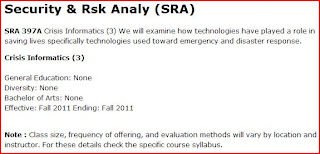Reflection on the class:
Overall I enjoyed taking this class; it was a lot more interesting than previous SRA classes I have taken in the past. I like the way the class was designed; everything from the class reading, class leaders, weekly blog posts, and guest speakers was interesting. I feel like this was a perfect combination of assignments to get the class information across and it kept me interested.
Usually I get bored with reading class material in most of my classes, but the material assigned in this class was great. I really enjoyed the weekly readings assigned to the class each week. I felt like I learned something new every time I read each article. On top of that, I found the readings to be interesting and informative. A lot of the articles were full of statistics and percentages, but the authors kept me in-tune by providing graphs and tables to depict the point they were trying to get across.
Throughout the semester each student was assigned to be a leader for one of the weekly assigned readings. I think this was an excellent idea because I had to really understand each article I was assigned to present that week in class. I also had to understand the other information assigned because, we had to be prepared to ask question to each of the students who presented during that class. I also learned a lot of information because the students did of great job of NOT boring the class to death by what I like to call “death by power-point.” Instead of presenting the assigned reading material by reading material verbatim off of a power-point, each student kept their presentations short and to the point.
 The weekly blog posts were something I wasn’t used to. At first I didn’t think I was going to like being required to blog about class information each week. But, it turns out it wasn’t so bad after all. I actually enjoyed reading what other students thought about the class that week or what they thought about each speaker we had. By blogging with the class I was able to view my opinions from different angles and maybe be influenced by the way other students thought about the subject. We also had to reply to at least two other blog posts each week. This gave me the chance to see what other students thought about my opinions and idea, and it also gave me a chance to let other students know what I thought about their blogs.
The weekly blog posts were something I wasn’t used to. At first I didn’t think I was going to like being required to blog about class information each week. But, it turns out it wasn’t so bad after all. I actually enjoyed reading what other students thought about the class that week or what they thought about each speaker we had. By blogging with the class I was able to view my opinions from different angles and maybe be influenced by the way other students thought about the subject. We also had to reply to at least two other blog posts each week. This gave me the chance to see what other students thought about my opinions and idea, and it also gave me a chance to let other students know what I thought about their blogs. In SRA 397A we had a variety of speakers come to State College to speak to our class about the occupations and achievements. It was cool to hear about what our guest speakers have done in the past and what the plan to do in the future. It was cool to have them come and speak in person because the class was able to interact with the guest and directly ask questions and get involved with the presentations. I didn’t particularly enjoy the telecom presentations; they tended to bore me, and were usually having technical difficulties. Over-all, I really enjoyed hearing from the guest speakers; they were able to put our class material into perspective for me.
I think IST, SRA, and Penn State students who took this class are going to be well suited for addressing issues arising the integration of technologies into crisis response, simply because the class now has a heads up on crisis management and disaster response. Through guest speakers and the assigned reading we now have a vast knowledge of what technologies have worked in the past and was technologies are possibly needed in the future for crisis responses. Our guest speakers have us a first-hand look at what goes on in disaster responses and what could use improvement. So, by taking this class I definitely think the class is ready to address issues with integrating technologies into crisis response.








